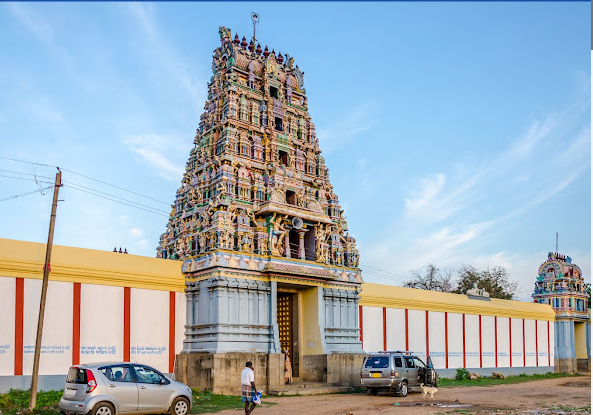Origin/History :-
The Seeyathamangai Ayavandeeswarar Temple, historically known as Ayavantheesam, is located in the region once referred to as Sathamangai. Over time, Sathamangai transformed into Seeyathamangai, as it is known today. The temple's presiding deity, Shiva, is called Ayavanthi Udaiyar in one of the inscriptions from the Chola era. This temple dates back to the early Chola period, and the inscriptions provide evidence of royal patronage. It is one of the 276 Paadal Petra Sthalams, meaning it was revered in the hymns of Tamil Saivite saints, specifically in the Tevaram composed by Tirugnanasambandar.
The temple's prominence during the Chola dynasty is reflected in its architecture and inscriptions, which indicate contributions made by kings for the upkeep of the temple and for the performance of rituals.
Puranic Significance :-
- Tiruneelanakka Nayanar and the Ayavandeeswarar Temple
Tiruneelanakka Nayanar was a revered Nayanar saint in the Shaivite tradition, recognized as the twenty-eighth among the 63 Nayanars. He lived during the first half of the 7th century CE and was a contemporary of the prominent saint Sambandar. His life and devotion are chronicled in the Periya Puranam by Sekkizhar in the 12th century, a hagiography detailing the lives of the Nayanars. Notably, he is mentioned by Sundarar in the Tiruthonda Thogai, where he is referred to as Nilanakkan of Sattamangai, and his life is also honoured in a hymn by Sambandar.
Tiruneelanakka Nayanar was born in Thirusathamangai, an important town in the Chola kingdom, which is now known as Seeyathamangai. He hailed from a Brahmin family tasked with reciting Vedic scriptures. A devoted Shiva follower, he served the devotees by washing their feet and welcoming them into his home, adhering strictly to Agamic rituals in his worship.
One significant incident occurred on a Poornima (full moon day). While performing his daily worship of the Shiva Lingam, a spider fell onto the Lingam. In some versions, Tiruneelanakka's wife blew away the spider, causing her saliva to land on the Lingam. Considering this act blasphemous, Tiruneelanakka confronted her about contaminating the sacred Lingam. Angered, he abandoned his wife, who chose to stay in the temple that night.
In his dreams, Lord Shiva appeared to Tiruneelanakka, revealing that the area touched by the spider's poison was swollen, while the part touched by his wife remained normal. This revelation taught Tiruneelanakka that love and devotion surpass mere ritualistic practices. The following dawn, he joyfully returned to the temple to worship Ayavandeeswarar and reconciled with his wife.
Tiruneelanakka continued his dedicated service to Shiva and his devotees. Hearing of Sambandar's reputation, he eagerly awaited the saint's visit. Upon Sambandar's arrival, Tiruneelanakka decorated Thirusathamangai and warmly hosted him, ensuring all accommodations for Sambandar and his entourage, including the low-caste couple Tiru Neelakanta Yazhpanar and his wife, after Sambandar insisted on their inclusion.
Sambandar and Tiruneelanakka visited the Ayavandeeswarar temple together, where Sambandar composed a hymn in honour of both the deity and Tiruneelanakka. Although Tiruneelanakka wished to accompany Sambandar on his travels, the young saint instructed him to remain in Thirusathamangai to continue serving the deity and his devotees.
Later, Sambandar invited Tiruneelanakka to officiate his wedding in Thirumana Nallur (now Achalpuram). Following the ceremony, the wedding party visited the Shivaloka Thyagar Temple, where Sambandar prayed for salvation. Lord Shiva appeared as a blazing flame, granting the wish, and Tiruneelanakka, along with Sambandar and the wedding guests, merged into the divine light of Shiva.
An image of Tiruneelanakka Nayanar is worshipped in the Ayavandeeswarar temple, particularly during the Tamil month of Vaikasi, when the moon enters the Mula nakshatra. He is depicted with a crown and folded hands, receiving collective worship among the 63 Nayanars.
- The Rebuilding of the Temple
In a later account, a group of Chettinad traders passing through Thirusathamangai encountered a young girl who invited one of the elders to visit the dilapidated temple in the village. Enchanted by her divine appearance, the elder agreed. However, upon entering the temple, the girl vanished, prompting the traders to believe it was a divine play by the Goddess. Moved by the temple's state, they decided to rebuild it, ensuring the continuation of Tiruneelanakka Nayanar's legacy and the worship of Ayavandeeswarar.
